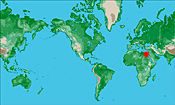







| Temperature: |
Average of 38°C (day), average of -3.9°C (night)
|
||||
|---|---|---|---|---|---|
| Precipitation: |
About 250 mm of rain per year
|
||||
| Vegetation: | Cacti, small bushes, short grasses
|
||||
| Location: |
Between 15° and 35° latitude (North and South of the equator); examples are Mojave, Sonoran, Chihuahua, and Great Basin (North America); Sahara (Africa); Negev (Middle East); and Gobi (Asia)
|
||||
| Other: | Perennials survive for several years by becoming dormant and flourishing when water is available. Annuals are referred to as ephemerals because some can complete an entire life cycle in weeks.
|
||||
| Example: | El-Oasr el-Akhdar, Egypt
| ||||
| Description: |
Desert biomes are the driest of all the biomes. In fact, the most important characteristic of a desert is that it receives very little rainfall. Most deserts receive less than 300 mm a year compared to rainforests, which receive over 2,000 mm. That means that the desert only gets 10 percent of the rain that a rainforest gets! The temperature in the desert can change drastically from day to night because the air is so dry that heat escapes rapidly at night. The daytime temperature averages 38°C while in some deserts it can get down to -4°C at night. The temperature also varies greatly depending on the location of the desert.
Since desert conditions are so severe, the plants that live there need to have adaptations to compensate for the lack of water. Some plants, such as cacti, store water in their stems and use it very slowly, while others like bushes conserve water by growing few leaves or by having large root systems to gather water or few leaves. Some desert plant species have a short life cycle of a few weeks that lasts only during periods of rain.
|
||||
| Links: |
Desert Topics Biome: Desert Deserts Joshua Tree National Park The Desert in Bloom (Arizona-Sonora Desert Museum) (A new browser window will open for each.) |
||||


